Introduction
This research is carried out in order to explore on “creation of a device that can serve as a tool for communications using EEG waves structurally converted to aesthetically pleasant music.” (Contextualization Essay 1). The study is of considerable significance because of meditational properties of music identified extensively without counter. The analysis conducts a voyage through various technologies available seeking out EEG for our study and identifies similarities available for EEG and sound especially music waves. The methods of comparing music and brain signals are adopted, so that characteristics of music to be used are effectively recognized. Neurological aspects and creativity are connected hand in hand to achieve a better treatment possibility in medical science. The method accesses music as a neuro feedback which can easily reach the required state of brain activity. Thus, at the end of this study, a proper idea on curative ability of music is attained which replaces EEG waves in neurological department of medicine.
Relevance of research
The research on conversion of EEG to music equivalent is relevant in many aspects especially healing magic of music. The topic under discussion is being considered to be important worldwide which can be illustrated through the quote from a paper presented by Cleveland Clinic Arts & Medicine Institute with an alliance to Lincoln Centre, saying “one of our goals for the day is to uncover ideas and perspectives about the novel field of “Neuromusic,” which studies the effect of music on the normal and abnormal physiology of the nervous system.” (Cleveland Clinic Arts & Medicine Institute). The relationship between brain and music is inevitable because brain itself creates music of various tone, pitch etc. which is responsible for various psychological and neurological states of the brain. Michael Roizen, MD is the Chief Officer at Cleveland Clinic Wellness Institute who explains the link of music and brain; he identifies that “Music Makes You and Your Brain 10 Years Younger”; where we know that age is something related to brain and brain activities. (Cleveland Clinic Arts & Medicine Institute). If music can change the mode of brain activities to some fresh states, then the same link can be utilized for neuro feedback and neuro music therapy. In this contemporary world of stress and depression, music therapy will be a boon eliminating chemicals and drugs for the treatment which can have side effects. Nowadays, there is a wider acceptance as “Brain Music Therapy is a scientifically supported treatment that transcribes your own unique brain waves and translates them into unique musical compositions” which helps in controlling and redirecting states of brain. (Peter).
Waves and Sound Waves
We know that “sound is a regular mechanical vibration that travels through matter as a waveform” which exhibits all characteristics of longitudinal waves. (Kurtus).The sound waves with specific characteristics can be viewed as music; “music is a sound that we enjoy hearing.” (Dorrell 18). Alterations of ordinary sound in tone, note, time durations etc. create melody or music. The words of N’Diaye K. “a distributed network of brain areas has been repeatedly evidenced in timing tasks” identify musical touch of brain waves and activities. (N’Diaye, Garnero and Pouthas). Each state of brain is represented by certain waves called brain waves. Gamma, Beta, Alpha, Theta and Delta are the recognized brain waves. Gamma waves (30 to 70 Hz) are produced while “processing of various attended stimuli…. From an EEG point of view, they will be present mostly while a subject is awake, but they will always be supported by other waves in the beta, alpha, theta, or delta ranges.” (Instant meditation: The Concept). Usual considerations are given to main brain waves excluding supporting gamma waves. “Brainwave activity tends to fall into four groups: beta, alpha, theta and delta. These categories are associated with the rapidity of oscillation (frequency) of brainwaves.” (Brainwaves).
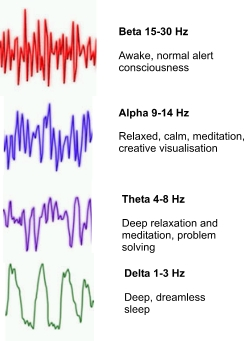
There can be a query why usage of sound waves itself is adopted, why not light or visual rays. This can be cleared out by understanding that EEG signals can be easily represented by sound waves due to similarity of both in many of their characteristics. It is accepted without a second thought because “scientifically proven that brainwave’s frequency in our brain can be altered to a desired frequency using specialized sound waves” as frequencies and corresponding state of brain are known evidently. (Instant meditation: The Concept). The selection of sound waves instead of light or visual rays is due to the properties of light itself. “Light is composed of transverse waves in an electromagnetic field….The denser the medium, the greater the speed of sound. The opposite is true of light…. Sound travels through all substances, but light cannot pass through opaque materials.” (Comparison of Light Waves with Sound Waves). The stated properties of light make irrelevant to be compared with EEG signals which are more alike sound waves.
Brain Waves to Music – Methods & Analysis
Many methods are available to be employed in analysing various factors involved in transforming brain waves to music. Power spectrum analysis and Discrete Fourier Transform techniques are suitable for our context. “The Fourier Transform of the Autocorrelation Function is the Power Spectrum.” (Nyack). Power spectrum is used in analysing various images which finds application in this investigation as well. “The first step in PSA is to Fourier transform the image I(x, y) and calculates the square modulus of the FT to generate the power spectrum, p (u, v). So, p (u, v) = |FT [I(x, y)] |2.” (Power Spectral Analysis). Later obtained FT array is rearranged according to frequencies in a way “that the zero frequency is in the centre of the array, the 1st quadrant is in the upper right, the second in the upper left, etc.” (Power Spectral Analysis). Resulting array is later converted to get values from 1.0 to 10.0 whose logarithm to base 10 is obtained. The obtained array is then used to obtain required equivalent; here brain waves undergo power spectrum analysis to get music equivalent for them.
Discrete Fourier Transform (DFT) is another procedure carried out. “The Discrete Fourier Transform (DFT) allows the computation of spectra from discrete-time data… in discrete-time we can exactly calculate spectra.” (Johnson). The definition itself explains relevance of this method in our analysis of brain waves. Accurate computation is significant for conversion of brain waves to music waves so that least redundancies result.
Recording and Interpretation – Technologies
There are several technologies which facilitate recording and interpretations of brain waves, namely EEG, MEG, MRI scan, CT scan etc. “Magneto encephalography (MEG) is a non-invasive neurophysiological technique that measures the magnetic fields generated by neuronal activity of the brain.” (Basic principles of Magnetoencephalography).
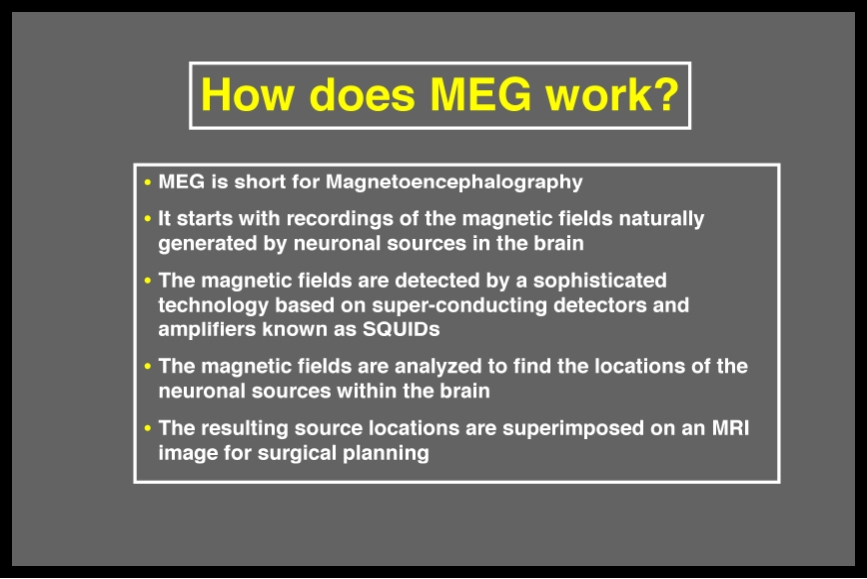
MEG involves capturing of magnetic fields inside the brain generated by various neurons. EEG, electroencephalogram technique is used to capture pictures of brain before, after and while performing any action. This tool helps us to “detect the location and magnitude of brain activity involved in the various types of cognitive functions.” (Weissman). Thus, it facilitates the study of brain status at any point of time. MRI scan differs from EEG or MEG with many properties as “an MRI (or magnetic resonance imaging) scan is a radiology technique that uses magnetism, radio waves, and a computer to produce images of body structures” (Shiel). It can find out only structural variations of human body parts. Similar is the case of CT scan, which is used to image human body parts in minute details. “CT imaging is one of the best and fastest tools for studying the chest, abdomen and pelvis because it provides detailed, cross-sectional views of all types of tissue.” (CT – Body). This technique is widely used in diagnosis and treatment of dreaded diseases like cancers, tumours etc.
After analysing all available techniques, it becomes evident that only EEG can find out the status of brain during various activities. Thus, EEG is used in our study on brain music. At the same time, brain waves are used instead of pulse or heart beat because brain is the part of body which is the source of all activities. The control of any activity is from brain itself, even pulse rate and heart beat are under its dictation. So, influence on bodily activities depends on brain waves alone.
Installation of an EEG unit poses many restrictions like size, cost etc, thus concluding with the usage of pendant EEG. “Pendant-EEG is a lightweight 2 channel EEG unit that can be clipped to your clothing and connects to your computer via a wireless receiver.” (Pendant-EEG).
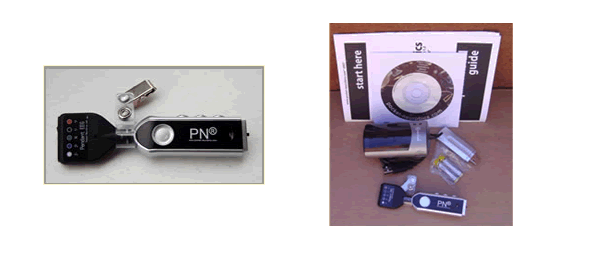
The above image is a wirelessly communicating pendant EEG. The communication essential for the application is given through wireless technique with efficiency by this. Our application can be relied with confidence on pendant EEG as “it can reliably process signals from 0.1 to 56 Hz.” (Pendant-EEG).
Position of Electrodes
The electrodes in EEG should be positioned in a specific manner. “The accuracy of the positional measurement of the EEG electrodes on the patient’s head has a direct influence on the consistency of the results.” (ELPOS 2). This explains the importance of electrode positioning in EEG. There are many instruments developed only for proper positioning of EEG electrodes.
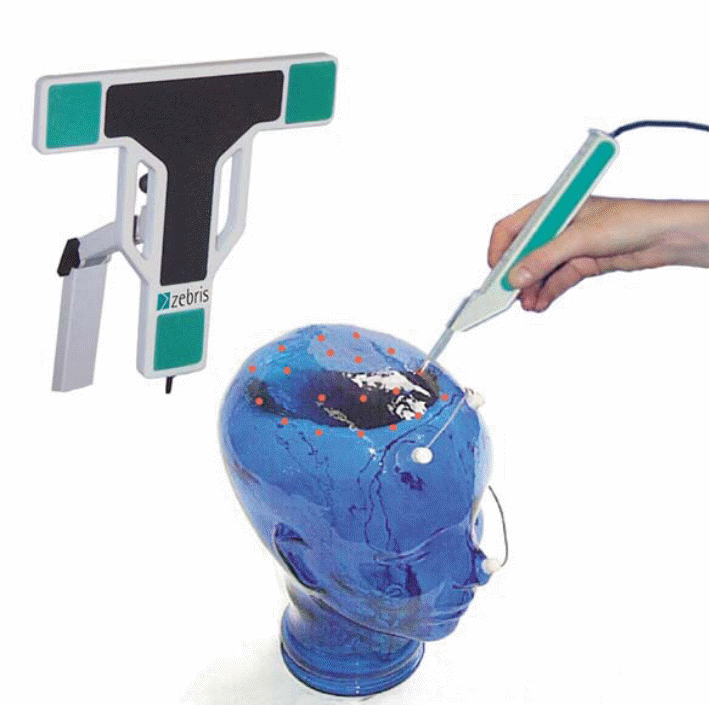
The positioning of electrode srae predefined but those are determine using various experimentations. “RADIOGRAPHIC OBSERVATION OF THE ELECTRODE POSITION DURING STEREOENCEPHALOTOMY” explains on it elaborately. They describes that it “is computed preoperatively from the co-ordinates of the respective area in relation to intracerebral reference points that are visualised by X-ray studies, usually after airfilling of the ventricles.” (Spiegel 278). The deduced results show the actual electrode positioning of brain. The products like ELPOS were introduced to the market in order to make the positioning of electrodes prior to EEG in an easier as well as accurate manner.
Brain Structure & Music
In our study, it is important to identify the part of brain responsible for creating music. The two hemispheres make up major portion of brain while “right hemisphere is associated with creativity and the left hemisphere is associated with logic abilities.” (Brain Structures and Their Functions). The functions of right and left hemispheres make it clear that both are involved while brain creates music. “Accepted neurological theories suggest that the right hemisphere deals with special elements like pitch whereas the left is responsible for the structure and progress of the melody (Heslet, 2).” (Contextualization Essay 2).
Dr. Daniel J. Levitin is a music scientist who compiled the book “This Is Your Brain on Music: The Science of a Human Obsession” which explained “how our brains interpret music.” (Levitin). In the course of his research on the topic, he conducted studies on relations between neural regions and music. His experiments illustrated the fact of involvement of both hemispheres in creating music.
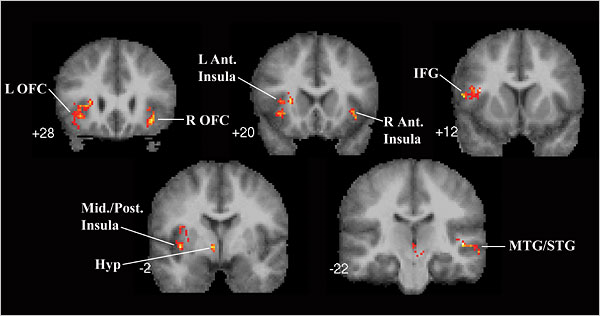
“Images from an experiment to locate the neural regions of the brain involved in listening to music. Daniel Levitin and another scientist scanned the brains of 13 people as they listened to scrambled and unscrambled versions of a tune.” (Thompson).
The footsteps of Daniel and others are still being followed. The studies on brain structure linking with meditation and music has reached even up to religious believes prevailing. “Using the brain scan called functional magnetic resonance imaging, the scientists pinpointed regions that were active during compassion meditation.” (Mediation Alters Brain Structures). These studies have sought out the points on brain linked to meditation or music. The research on this has found out the scope of meditating music for neurological treatment. “Activity in the left prefrontal cortex (the seat of positive emotions such as happiness) swamped activity in the right prefrontal (site of negative emotions and anxiety), something never before seen from purely mental activity.” (Mediation Alters Brain Structures).
The link of brain structuring to meditational music experienced is a realistic success for neurology.
Sonification of Neural Signals
There are various distinct processes involved in converting neural signals to sound signals or sonification of neural signals. It is a fact that “analyzing multichannel EEG signals using sounds seems a natural method: using a sonification of EEG signals…. perceive simultaneously every channel, and analyze more tractably the time dynamics of the signals – hoping to gain new insights about the brain signals.” (Vialatte and Cichocki). The sonification of neural signals is done in various steps having separate set of procedures. “This process will consist of the following stages: 1) data acquisition 2) data pre-processing: 3) intermediate representation (the creation of visual and sonic map); 4) visualization and sonification (Brouse et al, 9).” (Contextualization Essay 2). Usually, Data acquisition process is defined as “the phase of data handling that begins with the sensing of variables and ends with a magnetic recording or other record of raw data;” here pendant EEG. (Data Acquisition). The data recorded then undergoes preprocessing during data preprocessing stage. ”Data preprocessing describes any type of processing performed on raw data to prepare it for another processing procedure.” (Data Preprocessing). In sonification activity, data preprocessing is done to get relevant input to represent data before creating the actual visual and sonification output. Visualization can be defined as “a tool or method for interpreting image data fed into a computer and for generating images from complex multi-dimensional data sets” which is responsible for representing recorded data into visual patterns. (Owen). Visualization is accompanied by sonification which “is the transformation of data relations into perceived relations in an acoustic signal for the purposes of facilitating communication or interpretation” where in our application music is produced at the end. (Hermann).
Various experiments were carried out for deducing some efficient approach for sonification process. Researchers from Georgia Institute of Technology 840 McMillan St. Atlanta were among those. They were in search of “aesthetically satisfying and educationally useful representation of complex datasets of neural activity through hands-on interaction” sonification procedures. They succeeded in it by their reach to introduce the triumph project on “framework of the “Fish and Chips” project (in collaboration with the Symbiotic Research Group, Perth Australia [14]), where we sonified low resolution audio signal from an in-vitro culture of fish neural cells.” (Weinberg and Thatcher 246). The results and conclusions of above experimental project lead to their actual invention of requisite. ““BrainWaves”, in which we analyzed higher-resolution signals, allowing a group of players to interact
and manipulate the data in a performance setting using new tactile controllers that we have developed.” (Weinberg and Thatcher 246). These experiments are a few milestones in sonification sector of neurology.
Impacts of Neuro feedback Music
“Neuro feedback training is brainwave biofeedback.” (Hammond 1). The brain waves are fed back to brain cells so that it helps in attaining a pleasant frequency of brain activity. This method can be viewed as “exercising or doing physical therapy with the brain, enhancing cognitive flexibility and control.” (Hammond 2). By doing this, variations to brain waves can be achieved. But, it is a fact that brain waves are responsible for various activities and moods of an individual. So, through keen analysis and investigation, it becomes possible to change a mood to another by employing neuro feedback. There is extensive experimentation carried out to analyse impacts of Neuro feedback Music. Department of Cognitive Neuroscience and Behaviour, Faculty of Medicine, Imperial College London, St Dunstan’s Rd, London is an association that explored on the matter through their experiments. They mainly relied on two separate experiments they conducted. “In experiment 1, a group of students was trained on the SMR, beta1, and a/t protocols and performance changes were compared to a no-training control group and a group receiving additional interventions.” (Egner and Gruzelier 1221). The variations in performance brought about by three different neuro feedback protocols were evaluated. “In experiment 2, different neuro feedback protocols were trained in separate groups and performance changes were contrasted with comparison groups undergoing alternative interventions.” (Egner and Gruzelier 1221-1222). Both the experiments dug out the positive impacts of neuro feedback.
Conclusion
The research on conversion of EEG waves to aesthetically pleasant music presented a voyage through the vastness of brain activity and brain waves explored by various techniques including EEG, MEG, scan etc. The creativity of music is ready to conquer logical and emotional aspects of human brain by altering frequencies of brain waves to those of calm and pleasant status. It was wholly understood that it is a great success of medicine in identifying such a technology which can create least side effects like drugs or chemicals. Meditation and psychological treatments can be well successful through this approach of brain music. Thus, a fact is substantiated; brain creates music which can be altered by creativity of human brain itself.
Works Cited
Basic principles of Magnetoencephalography. n.d.
Brain Structures and Their Functions. Serendip, 2009. Web.
Brainwaves. Meditations: Mind Matters, n.d. Web.
Cleveland Clinic Arts & Medicine Institute. Music and the Brain: A Symposium with Integrated Live Performances. Cleveland Clinic, Lincoln Center, 2009. Web.
Comparison of Light Waves with Sound Waves. Integrating Publishing, n.d. Web.
Contextualization Essay (Comparative Study): Rationale of the Project Proposal. (Provided by the customer).
CT – Body. Radiology Info: The Radiology Information Resource for Patients, 2010.
Data Acquisition. Answers.com, 2009. Web.
Data Preprocessing. Search SQL Server.com, 2010.
Dorrell, Philip. Chapter 2: What is Music?. n.d.
Egner, Tobias. And Gruzelier, John H. Ecological Validity of Neurofeedback: Modulation of Slow Wave EEG Enhances Musical Performance. Cognitive Neuroscience and Neuropsychology. 2002. Web.
ELPOS: Localisation and Repositioning of EEG Electrodes 3D Digitization of the Shape of the Cranium. Zebris Medical GmbH, 2005. Web.
Hammond, D. Corydon. What is Neurofeedback?. International Society for Neurofeedback & Research, 2006. Web.
Hermann, Thomas. Sonification – A Definition. Sonification.de, 2006. Web.
Instant meditation: The Concept: Brainwaves Frequencies and Their Characteristics. Meditation is Easy, 2007. Web.
Johnson, Don. Discrete Fourier Transform (DFT). Connections, 2009.
Kurtus, Ron. Overview of Sound Waves: Sound is a Mechanical Vibration. School for Champions, 2009.
Levitin, Daniel J. This Is Your Brain on Music: The Science of a Human Obsession. New York: Penguin Group (USA) Inc., 2006.
Mediation Alters Brain Structures. UrbanDharma.org. 2004.
N’Diaye, K., Garnero, L. and Pouthas, V. EEG and MEG Source Imaging in Duration/Pitch Comparison. n.d.
Nyack, Cuthbert. Fourier Transform Autocorrelation and Power spectrum. 1996.
Owen, G. Scott. Definitions and Rationale for Visualization: Definition. 1999. Web.
Pendant-EEG. The Learning Curve Inc., 2004. Web.
Peter, Orli J. Brain Music Therapy. Dr. Orli Peter Center for Accelerated Psychology, n.d. Web.
Power Spectral Analysis. 1994.
Shiel, William C. Magnetic Resonance Imaging (MRI Scan). Medicine Net.com: We Bring Doctors’ Knowledge to You, 2010.
Spiegel, E. A., et al. Instrumental and Technical Notes: Radiographic Observation of the Electrode Position During Stereoencephalotomy, XXX(353). 1957. Web.
Thompson, Clive. Music of the Hemispheres. The New York Times, 2006.
Vialatte, Francois B. and Cichocki, Andrzej. Sparse Bump Sonification: A New Tool for Multichannel EEG Diagnosis of Mental Disorders; Application to the Detection of the Early Stage of Alzheimer’s Disease. Springer, 2006. Web.
Weinberg, Gil. and Thatcher, Travis. Interactive Sonification of Neural Activity. Google docs. 2006. Web.
Weissman, Daniel. What is EEG?: How EEG Works. Michigan: Attention and Cognitive Control Laboratory, n.d. Web.